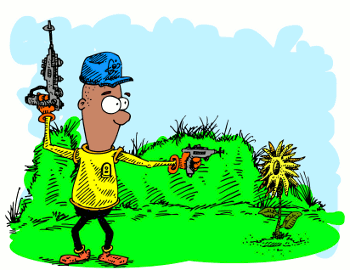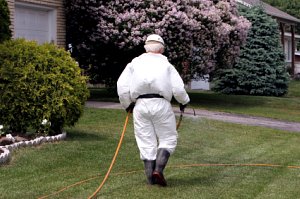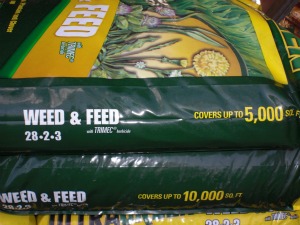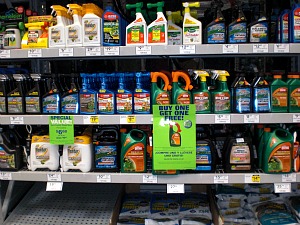Herbicides are a group of pesticides that are utilized for lawn weed control. Any substance applied to prevent or kill weeds is considered an herbicide including natural, organic or man-made synthetic materials.
These products are valuable tools for landscape and lawn weed control applications. When used correctly they will not damage lawns, trees or ornamental plants. However, a common misunderstanding is herbicides only kill weeds while they are actually designed to kill plants (weeds are just plants growing where we don’t want them). Misapplication of a weed killer usually results in damage to valuable lawns and landscape plants or harm to the environment.
What we cover
ToggleMisapplication is the Major Problem with Pesticides!
Proper herbicide application includes:
- Weed Identification
- Selecting the best product
- Reading and following the label
Read and Follow the Label!
Before using any chemical for lawn weed control, it is very important to read and follow the instructions on the product label. Many problems associated with pesticide use are the result of misapplication and could have been prevented if the applicator had read, understood and followed the instructions.
More is not better and too much often results in damage to non-target plants. The label is the law and it will help you get the best results from the product as well as prevent injury to your lawn or desirable plants.

Types of Herbicides
There are several types of herbicides and they are categorized according to when they are applied, method of application, and how they kill weeds.
To select the best lawn weed killer, you must understand how herbicides are applied, when they should be applied and how they can be used to kill only targeted weeds without damaging the lawn or other valuable plants.
Herbicides utilized for lawn weed control are either:
- Pre-emergent or Post-emergent
- Selective or non-selective
- Applied directly to plant foliage or to the soil
- Liquid or granular
- Contact or systemic (translocated)
Application Method: Liquid or Granular
Herbicides are either applied directly to the weed leaves or they are applied to the soil. In either case, they can be sprayed as a liquid mix from a sprayer or spread with a fertilizer spreader in a granular form.

Granular herbicides are not as effective as liquid formulations when used to control actively growing weeds because the granules need to stick to the plant foliage and remain there for up to 48 hours…liquids stick to leaves better than granules. If you choose a granular weed and feed, the best time to apply is when leaves are wet, so they stick, in the morning dew or after rainfall or irrigation.

Timing: Pre-emergent or Post-emergent
Pre-emergence herbicides (often called crabgrass control) are used to prevent weeds from growing by killing germinating seedlings, they are applied before weeds sprout (in early spring or late fall) and generally work by preventing new seedlings from growing into mature plants.
Weeds are prevented by the formation of a thin chemical barrier at the soil surface. Sprouting seedlings are killed when they contact the treated area and absorb the chemical. Pre-emergents are most often used to control annual grassy weeds such as crabgrass and annual bluegrass, they are also very effective at controlling several other types of weeds that that spread by seed.
Pre-emergents are applied to the soil in a liquid or granular form and need to be activated by rainwater or irrigation. Common pre-emergents for home lawns are mixed with fertilizer in granular form and can be applied with a fertilizer spreader.
Post-emergents are used to control actively growing weeds. They are the most common type of herbicide used to control lawn weeds. Post-emergents are either contact or systemic and foliar or root absorbed. They include selective broadleaf and grassy weed killers as well as non-selective chemicals such as Roundup.

Post-emergent herbicides are generally most effective when applied to actively growing weeds, when temperatures are between 60 and 85 degrees and applied before mowing and then waiting 48 hours to mow.
How Herbicides Injure Plants Contact vs. Systemic
Contact herbicides only kill the part of the plant that is sprayed. They are applied to foliage and uniform coverage is very important. For best results, the entire plant must be sprayed. Damage often appears within hours and is usually the result of cell membranes being destroyed and plant tissues drying out.
Contact weed killers do not kill the root system of perennial weeds or other underground structures such as rhizomes, tubers and bulbs. Repeat applications are usually required to kill perennials. Contact weed killers are best used to control annual weeds.
The systemic (or translocated) chemicals are absorbed into the plant through roots or leaves and are translocated throughout the entire plant down to the roots and shoots. Systemic weed killers are more effective at controlling perennial weeds than contact herbicides
Chemistry: Selective or Non-Selective
Selective herbicides are designed to kill only targeted weeds while doing little or no damage to lawn grasses. Spraying dandelions in a lawn with a broadleaf weed killer such as 2,4-D is an example, it kills the dandelions while doing no damage to the grass.
Non-selective weed killers control all plants regardless of species. Glyphosate (Roundup) is an example, it will kill or damage any plant that is sprayed. Non-selective chemicals can be used to control weeds growing in sidewalk cracks, landscape beds or as part of a lawn renovation.
More weed control tips:
Kill dandelions by using cultural, chemical or organic weed control methods. Thwart future invasions of dandelions into your lawn and landscape beds.
How to Kill Weeds: Eliminate lawn weeds without killing grass and prevent their return. Helpful DIY lawn care tips and advice. Mowing, watering, fertilizing, pest control and more.
